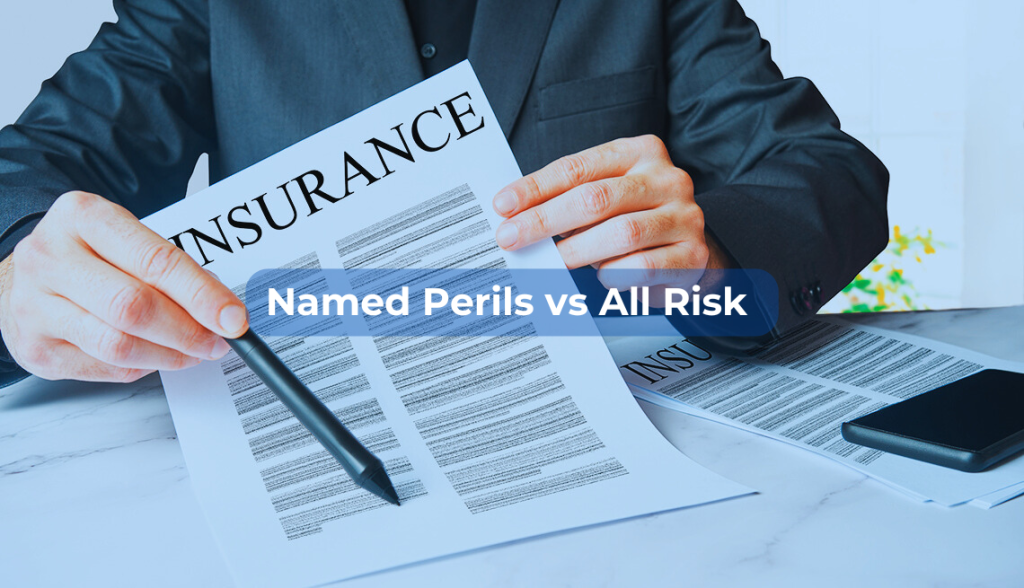Choosing the right insurance coverage can be overwhelming, especially when deciding between Named Perils and All Risk Coverage. Both options offer varying levels of protection, but their differences can significantly impact how effectively they meet your needs.
Named Perils Coverage offers a more focused scope, protecting against specific risks, while All Risk Coverage provides broader protection by covering almost everything unless explicitly excluded. Understanding these distinctions is crucial for choosing a policy that aligns with your property’s risks and your personal or business needs. This article breaks down each type of coverage, comparing named perils vs all risk coverage and their features, costs, and suitability to help you make an informed decision.
What Is Named Perils Coverage?
Named Perils Coverage offers protection for specific events or risks that are explicitly listed in the policy. If an event isn’t listed, the insurer won’t cover the damage or loss caused by it. The policyholder exactly knows upfront which risks are covered, offering a more controlled form of protection.
Common perils included in a named perils policy might be fire, theft, vandalism, windstorms, and lightning. However, this type of coverage leaves out many risks that could potentially occur but are not named in the policy.
For instance, if a flood or earthquake isn’t listed, the policy won’t cover damages caused by those events, leaving gaps in protection. This often makes named perils suitable for those who want more affordable coverage and feel confident that the listed risks align with their property’s potential threats.
Key Features of Named Perils Coverage
- Only covers events specifically named in the policy.
- Tends to be more affordable than broader coverage options.
- Commonly listed perils include theft, fire, and vandalism.
- Provides limited protection, which may require additional coverage for exclusions.
What Is All Risk Coverage?
In contrast, All Risk Coverage (also known as open perils) provides protection against all possible risks or events, except those explicitly excluded from the policy. This type of insurance takes a broader approach, automatically covering all risks unless the policy specifies that a certain event is not covered.
The advantage here is a more comprehensive level of protection. For example, if an event like a burst pipe damages your property and isn’t specifically excluded, it will likely be covered under an All-Risk policy. However, there are common exclusions even in All-Risk policies, such as natural disasters like earthquakes or floods, which often require separate policies.
Common Exclusions in All Risk Policies
- Floods and earthquakes.
- Wear and tear or damage from gradual deterioration.
- Acts of war or terrorism.
Because of the broader range of protections offered, the premium for all-risk insurance is usually higher.

Cost Comparison
Cost is often a significant factor when choosing between Named Perils vs All Risk Coverage. All Risk is generally more expensive because it covers more events, offering a bigger safety net for policyholders. Insurance companies price All Risk policies higher to compensate for the additional risks they’re accepting by providing such extensive coverage.
On the other hand, Named Perils Coverage tends to have lower premiums because it only covers a select list of events, eliminating the chance that the insurer will have to pay for other claims. If you’re looking to minimize upfront costs and feel that the specific perils named in the policy are sufficient for your property’s needs, Named Perils might be the more economical option.
Flexibility in Claims
Another critical difference between the two coverages is how claims are handled. With Named Perils Coverage, the policyholder must prove that the damage resulted from one of the perils listed in the policy. This can be time-consuming and complicated in some cases, especially if the cause of damage is unclear.
For instance, if your home is damaged by a fire, you would need to demonstrate that the fire was caused by a peril listed in your policy for the claim to be processed. In cases where the damage’s cause isn’t covered, or it’s a grey area, the claim may be denied.
In contrast, All Risk Coverage shifts the burden of proof onto the insurer. The policyholder doesn’t need to prove that the damage was caused by a covered event; instead, the insurer must demonstrate that the damage was due to an excluded event to deny the claim. This can streamline the claims process, making it easier for policyholders to receive compensation.
Coverage Scope and Suitability
Named Perils Coverage is often best for low-risk properties or for individuals who have specific concerns about certain types of damage. For example, if you live in an area where certain risks are minimal (like earthquakes or floods), and your main concern is theft or fire, Named Perils might give you proper protection without the added cost of All-Risk Coverage.
On the other hand, All-Risk Coverage is ideal for those who want comprehensive protection, especially if the property is high-value or exposed to a wide range of risks. Commercial insurance coverage often leans toward All-Risk policies, as business owners need broader protection to safeguard their assets against unforeseen events that could result in significant financial losses.
Exclusions and Limitations
Regardless of which type of coverage you choose, it’s essential to understand the exclusions and limitations of each policy.
For Named Perils, the limitations are clear: anything not listed in the policy is excluded from coverage. This could leave you vulnerable to risks that you may not have initially considered. For example, if your property is damaged by a burst pipe but “water damage” is not listed as a peril, your insurance won’t cover the repairs.
While All-Risk Coverage offers broader protection, it still comes with exclusions that need to be considered. Common exclusions include natural disasters like floods and earthquakes, wear and tear, and intentional damage. Policyholders must read through these exclusions carefully to ensure they are not blindsided by uncovered events.
Understanding these exclusions is critical because even the most comprehensive policy won’t cover everything. Reviewing policy exclusions with an insurance agent is an effective way to ensure you’re properly protected.

Making the Right Choice
When deciding between Named Perils vs All Risk Coverage, there’s no one-size-fits-all solution. The best choice depends on your individual requirements, such as the value of your property, your budget, and the level of risk you’re willing to assume.
For someone looking to minimize costs and protect against only the most likely risks, Named Perils Coverage may be the better option. However, for those with higher-value assets or more significant exposure to a wide range of risks, All Risk Coverage provides broader protection.
Ultimately, consulting with an insurance agent can help clarify which policy makes the most sense for your specific situation. It’s crucial to weigh the potential gaps in coverage with named perils against the higher cost of all risk and assess which insurance best aligns with your needs.
Conclusion
Named perils vs all risk coverage both offer valuable protection, but the best choice depends on your specific needs and risk assessment. Named perils provide coverage for specific events at a more affordable cost, while all-risk coverage offers broader protection, covering almost everything unless specifically excluded.
Understanding the differences in coverage scope, costs, and claims processes is key to making an informed decision. Always evaluate your property’s risk profile and review policy exclusions thoroughly to ensure you are selecting the most suitable coverage. Consulting with an insurance agent can further help you navigate the complexities and choose the policy that best aligns with your protection needs.
